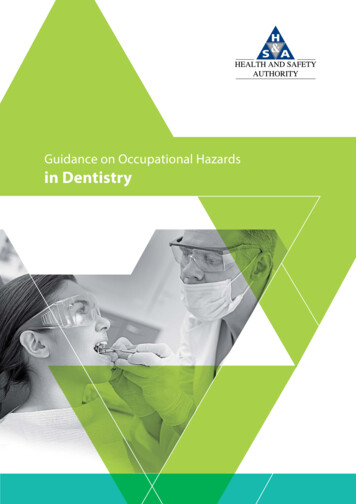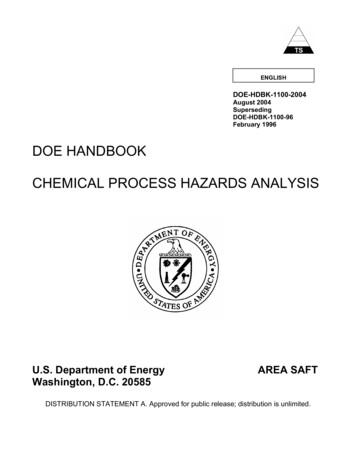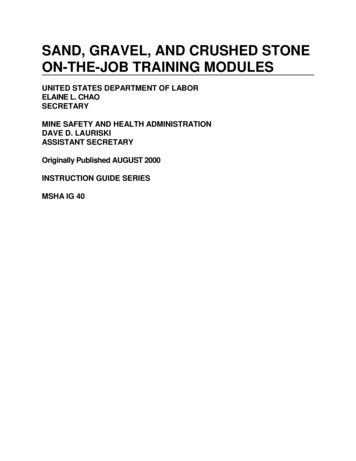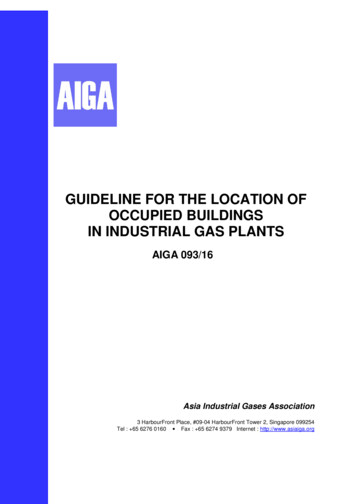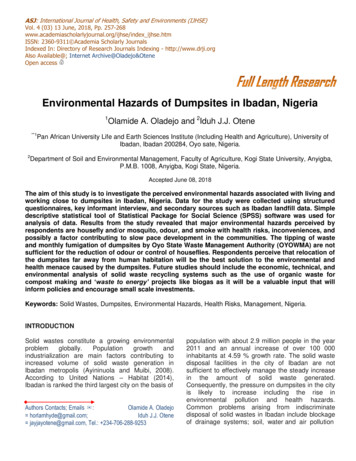
Transcription
ASJ: International Journal of Health, Safety and Environments (IJHSE)Vol. 4 (03) 13 June, 2018, Pp. x ijhse.htmISSN: 2360-9311 Academia Scholarly JournalsIndexed In: Directory of Research Journals Indexing - http://www.drji.orgAlso Available@; Internet Archive@Oladejo&OteneOpen accessEnvironmental Hazards of Dumpsites in Ibadan, Nigeria1Olamide A. Oladejo and 2Iduh J.J. Otene**1Pan African University Life and Earth Sciences Institute (Including Health and Agriculture), University ofIbadan, Ibadan 200284, Oyo sate, Nigeria.2Department of Soil and Environmental Management, Faculty of Agriculture, Kogi State University, Anyigba,P.M.B. 1008, Anyigba, Kogi State, Nigeria.Accepted June 08, 2018The aim of this study is to investigate the perceived environmental hazards associated with living andworking close to dumpsites in Ibadan, Nigeria. Data for the study were collected using structuredquestionnaires, key informant interview, and secondary sources such as Ibadan landfill data. Simpledescriptive statistical tool of Statistical Package for Social Science (SPSS) software was used foranalysis of data. Results from the study revealed that major environmental hazards perceived byrespondents are housefly and/or mosquito, odour, and smoke with health risks, inconveniences, andpossibly a factor contributing to slow pace development in the communities. The tipping of wasteand monthly fumigation of dumpsites by Oyo State Waste Management Authority (OYOWMA) are notsufficient for the reduction of odour or control of houseflies. Respondents perceive that relocation ofthe dumpsites far away from human habitation will be the best solution to the environmental andhealth menace caused by the dumpsites. Future studies should include the economic, technical, andenvironmental analysis of solid waste recycling systems such as the use of organic waste forcompost making and ‘waste to energy’ projects like biogas as it will be a valuable input that willinform policies and encourage small scale investments.Keywords: Solid Wastes, Dumpsites, Environmental Hazards, Health Risks, Management, Nigeria.INTRODUCTIONSolid wastes constitute a growing dustrialization are main factors contributing toincreased volume of solid waste generation inIbadan metropolis (Ayininuola and Muibi, 2008).According to United Nations – Habitat (2014),Ibadan is ranked the third largest city on the basis ofAuthors Contacts; Emails :Olamide A. Oladejo horlamhyde@gmail.com;Iduh J.J. Otene jayjayotene@gmail.com, Tel.: 234-706-288-9253population with about 2.9 million people in the year2011 and an annual increase of over 100 000inhabitants at 4.59 % growth rate. The solid wastedisposal facilities in the city of Ibadan are notsufficient to effectively manage the steady increasein the amount of solid waste generated.Consequently, the pressure on dumpsites in the cityis likely to increase including the rise inenvironmental pollution and health hazards.Common problems arising from indiscriminatedisposal of solid wastes in Ibadan include blockageof drainage systems; soil, water and air pollution
258.Int. J. Health, Safety and Environ.and health problems such as diarrhoea, cholera,and dysentery (Oyediran and Adeyemi, 2011;Omole and Alakinde, 2013; Moruff, 2014). Thechallenges to the management of solid wastes indeveloping countries like Nigeria include limited tal laws, poor town planning,lack of efficient and safe disposal and/or urement of environmental impact andassociated health hazards of unsafe disposal ofsolid wastes (Nubi, et al., 2006; Oyeniyi, 2011;Etusim, et al., 2013; Anyanwu and Adefila, 2014).The aim of this study is to investigate the perceivedenvironmental and health hazards associated withliving and working close to dumpsites in Ibadan,Nigeria as well as an overview of the managementof the dumpsites. Other objectives include:a.to identify strategies adopted for coping withenvironmental hazards by residents living andworking close to dumpsites in Ibadan, Nigeria.b.to provide an overview of respondents’perceived solutions to environmental hazardsfrom dumpsites in Ibadan, Nigeria.MATERIALS AND METHODSStudy areaIbadan is the capital city of Oyo State, Nigeriacomprising 11 local government areas (LGAs). Thecity is located in the south-western part of Nigeria(longitudes 3030'25" and 409'3" east of theGreenwich Meridian and latitude 7044'18" and702'39" north of the equator and about 145 kmnorth-east of Lagos, Nigeria). It has a total land areaof 3 123 km2 and is at an average altitude of about200 m above sea level. The city is characterized bylarge and small industries (agro allied andmanufacturing industries) and different types ofinstitutions (educational/research institutes, religiousand medical centers). The city of Ibadan is servicedby four dumpsites namely; Lapite, Ajakanga, Abaeku and Awotan, located in Akinyele, Oluyole, Onaara and Ido local government areas respectively(Figure 1). The four dumpsites are solely managedby the Oyo state government through the Oyo StateWasteManagementAuthority(OYOWMA).According to OYOWMA, Aba-eku is the oldestdumpsite established in 1985 while the largestdumpsite is Awotan occupying 20 hectares followedby Ajakanga, Aba-eku, and Lapite occupying 10,9.4, and 9 hectares respectively. Conversely,records from 2015 data of waste deposited atdumpsites revealed that Ajakanga had the highest(162 117 metric tons) of annual waste followed byAba-eku, Awotan, and Lapite (102 705, 95 775, and87 218 respectively). Furthermore, a decreasingtrend in the daily average volume and annual totalvolume of waste were recorded from the fourdumpsites from 2012 to 2015 (Figure 2). This couldbe as a result of increasing number of illegal refusedumps within the city of Ibadan.Data collectionKey informant interview (KII) was used to obtaindata on location and characteristics of thedumpsites including information on managementpractices by OYOWMA. Structured questionnairewas used to assess information on environmentalhazards from dumpsites, effects of environmentalhazards on residents, strategies adopted for copingwith environmental hazards including communalefforts for managing environmental hazards fromdumpsites, and respondents’ perceived solutions toenvironmental hazards from dumpsites. Out of 324questionnaires that were administered, a total of 304were filled and retrieved from respondents (surveyresponse rate 93.8 %).Population and SamplingStandard setback area of 250 meters referred to asminimum distance between a dumpsite andresidential developments by the United NationsEnvironment Programme (UNEP, 2005) was usedfor this study. Images of the four dumpsites inIbadan were obtained from Google Earth. Pointswere created on the images to serve as referencepoints. The images were inputted into ArcGIS 10.1software. The points created were geo-referencedand a buffer of 250 meters from the boundary ofeach of the dumpsites were created (example- seeAppendix 1 for Lapite Dumpsite). Taro (1967)technique for sample selection was used to derivethe sample size. Summary of population and samplesize is presented in Table 1.Taro’s formula: n * ((1)) Where: n sample size
Oladejo and Otene. 259Figure 1. Location of Ibadan and dumpsites.
260.Int. J. Health, Safety and Environ.(a) Daily average volume of waste deposited in Ibadandumpsites(b) Annual volume of waste deposited in Ibadan dumpsitesFigure 2. Daily average volume and annual total volume of wastedeposited in Ibadan dumpsites, Nigeria (Source: OYOWMAlandfill data 2012-2015).Table 1. Summary of Population and sample size.S/No1234DumpsiteLapiteAjakangaAwotanAba ekuTotalPopulationSample Size20802712392061080119105324
Oladejo and Otene. 261Table 2. Environmental hazards from dumpsitesin Ibadan, Nigeria.Environmental HazardSmokeOdourDustBlown litterRodent InfestationHousefly/ MosquitoWater pollutionNoise from waste .325.077.311.24.3N Total populatione error margin (at 95% confidence level)Total population for Awotan (271) and Abaeku (239)dumpsites 271 239 510Using Taro Yamane’s formula: n * () n 224 respondentsPercentage contribution 53.1 % and 46.9 % ple size for Awotan dumpsite 53 %224 119Sample size for Abaeku dumpsite 46.9 % 224 105The total population within buffer for Lapite dumpsiteand Ajakanga dumpsite (20 and 80 respectively)were used as sample size since they are small.Therefore, total sample size (total respondents forthe four dumpsites) 20 80 119 105 324.Data AnalysisData collected from the field were coded andanalysed using simple descriptive statistical tool ofStatistical Package for Social Science (SPSS,Version-22, SPSS Inc. New York, NY, USA)software. Descriptive statistics such as percentagewas used to summarize bulky data and for easyunderstanding results were presented using barcharts, line graphs, and tables.RESULTSEnvironmental HazardsIbadan, NigeriafromDumpsitesinField visits to the dumpsites revealed that wastesare not sorted before disposal at the dumpsites, asa result wastes such as food wastes, metals,industrial wastes, and plastics are depositedtogether (see Appendix 2). The environmentalhazards from dumpsites indicated by therespondents are smoke, odour, dust, blown festation and noise from waste trucks (Table 2).Respondents perceive that housefly and/ormosquito is the most experienced environmentalhazard from the dumpsites accounting for 77.3 %.Note: Total number of respondents 304N Number of responses to a particularenvironmental hazardPercentage N/ Total number of respondents * 100Effectsofenvironmentalhazardsoncommunities within dumpsites in Ibadan, NigeriaMajority of the respondents are of the view that theslow pace of development in their communities canbe attributed to smoke (38.9 %), odour (40.1), dust(46.2 %), blown litter (35.1 %), rodent infestation(32.1), housefly/mosquito (30.0 %), and waterpollution (36.8 %) from dumpsites (Figure 3).Strategiesadoptedforcopingwithenvironmental hazards by residents living andworking close to dumpsites in Ibadan, NigeriaIn coping with the environmental and health hazardsfrom dumpsites, majority (27.0 %) of therespondents stay indoors and shut their doors so asto reduce air pollution (inflow of smoke and odour)from dumpsites into their homes (Figure 4). This isfollowed by respondents who use insecticide(20.9%) to control both mosquitoes and houseflies;15.8 % who use window and door nets to restrict themovement of houseflies and mosquitoes into theirhomes, and 10.8 % who keep clean environment tocontrol houseflies. Communal efforts for managingenvironmental hazards from dumpsites in Ibadan ismainly by correspondence to local governmentswhere the dumpsites are located accounting for 50.7% of the respondents (Figure 5). The communitieshave on many occasions chosen representatives tovisit OYOWMA to make their plight known to themand to seek for a redress. However, majority (69.3%) of the respondents are of the view that therelocation of the dumpsites far away from human
Oladejo and Otene262Figure 3. Effects of environmental hazards on communities within dumpsites inIbadan, Nigeria.habitation will be the best solution to theenvironmental hazards from the dumpsites (Figure6). Also suggested were setting up efficient wasterecycling systems and regular fumigation of thedumpsites accounting for 12.3 and 11.9 %respectively.Control measures of environmental hazardsfrom Ibadan dumpsites by OYOWMAThe methods adopted by OYOWMA to control thevarious environmental hazards from the dumpsitesare summarized in Table 3. Fire/smoke is controlledat Ibadan dumpsites by tipping. This is done tocreate space for more refuse deposition and toreduce pore spaces in waste pile that could aid fireoutbreak. In the past, the state fire servicedepartment is called upon during fire outbreak butas fire outbreak became regular, the authority had todrill boreholes at the dumpsites to provide theneeded water to quench fire. Unfortunately over theyears, the boreholes have not been functional andin event of fire outbreak, the communities left tosuffer the adverse effects from such fires/smoke.
263.Int. J. Health, Safety and Environ.Figure 4. Strategies adopted for coping with environmental and health hazards by residentsliving and working close to dumpsites in Ibadan, Nigeria.Figure 5. Communal efforts for managing environmental hazards from dumpsites in Ibadan,Nigeria.Basically, Ibadan dumpsites are fumigated once in amonth to control houseflies and to reduce the odourthat emanate from dumpsites. Discussions duringthe KII revealed that fumigation once in a monthmay only be 40 % effective to control houseflies andreduce odour. Some respondents who confirmed
Oladejo and Otene264Figure 6. Respondents’ perceived solutions to environmental hazards from dumpsitesin Ibadan, Nigeria.Table 3. Dumpsites environmental control measures by OYOWMAEnvironmental hazardSmoke/fireOdourDustBlown litterRodent infestationHouseflyWater pollutionMethod of controlTipping and drilling of boreholes at dumpsitesMonthly fumigationNoneFencingNoneMonthly fumigationNoneSource: Key informant interview (2016).that the dumpsites are fumigated claimed that theeffect of the fumigation only last for 2 – 3 days.Therefore, weekly fumigation may be effective forcontrolling odour and house flies from thedumpsites. Discussions from KII revealed that thereare no control measures put in place for dust, rodentinfestation, and water pollution from dumpsites.Fencing for example the Aba-eku dumpsite is usedto control windblown litter. However, some areas ofthe fencing have fallen off leading to blown litterespecially polythene bags and other lightweightmaterials been trapped in nearby bushes and drainsaround the dumpsites.DISCUSSIONSEnvironmental and HealthDumpsites in Ibadan, NigeriaHazardsfromAir pollution caused by odour released from thedecay of biodegradables and smoke from open aircombustion of solid wastes are high at Ibadandumpsites with high tendency of GHG emissionssuch as methane and carbon dioxide. The strongstench from the dumpsites is due to the largerproportion of biodegradable wastes at thedumpsites. At favourable conditions like conducive
265.Int. J. Health, Safety and Environ.temperature and moisture for microbial activities,these wastes are decomposed. During thedecomposition process, unpleasant odour isreleased to the environment. The environmentalproblems from poor management of dumpsitesinclude air pollution from dust, odour or greenhousegas emissions such as carbon dioxide and ion of waste (Odeyemi, 2012; Zhao etal., 2015).The prevalence of housefly and/or mosquitoexperienced in the dwellings of respondents can beattributed to the dirty environment generated bydumpsites which serves as source of food andbreedingenvironmentforhousefliesandmosquitoes. Although dust, rodent infestation andwater pollution are not very common in Ibadandumpsites but if left unattended, they may lead tovery severe cumulative negative health andenvironmental hazards. For example, water pollutionfrom dumpsites occurs when leachates infiltrates thesoil to groundwater resources. Similarly, runoff fromdumpsites can pollute surface water resources.Leachates from dumpsites contain heavy metalssuch as chromium (Cr), zinc (Zn), copper (Cu),cadmium (Cd), lead (Pb) and nickel (Ni) which arenot only potential source of contamination to soiland water resources (surface water andgroundwater) but also harmful to human life as theyenter food chain through plant and animal uptake(Abdus-Salam, 2009; Kola-Olusanya, 2011; Magaji,2012; Egharevba, et al., 2013; Oni and Hassan,2013; Ukpong, et al., 2013; Ogu and Ogwo, 2014).Some of the health risks are respiratory problems,malaria, diarrhoea, cholera, chest pain, headache,fatigue, kidney diseases like nephritis, and can alsolead to the damage of the liver, brain, centralnervous system and reproductive system (Abul,2010; Odeyemi, 2012; Njagi, et al., 2013). Commonhealth risks mentioned by respondents living andworking close to dumpsites in Ibadan are respiratoryproblems and malaria.Management of Dumpsites in Ibadan, NigeriaIbadan dumpsites seem to be inadequatelyequipped to effectively manage daily averagevolume of 1258 metric tons and total annual volumeof 459005 metric tons of waste. Monthly fumigationof dumpsites by OYOWMA is not sufficient for thereduction of odour or to control houseflies. Poormanagement of dumpsites have adverse effects onthe environment and health risks for residents livingclose to the dumps (Ogunrinola and Adepegba,2012; Etusim, et al., 2013; Sankoh, et al., 2013).CONCLUSIONMajority of the respondents perceive that therelocation of the dumpsites far away from humanhabitation will be the best solution to theenvironmental and health menace caused by thedumpsites. Presumably, Oyo State Governmentmight not be ready to relocate the dumpsites due tocost which includes cost of structural facilities formanagement of waste and cost of transportingwaste from the city to proposed new dumpsites.Likewise, some of the dumpsites have been inoperation before human habitation in the area. Thegrowth rate of the city of Ibadan in terms ofpopulation and socioeconomic development mayrequire citizenry to call for relocation of dumpsites inthe nearest future when development spreads tonew sites. Therefore, relocation of dumpsites maynot address the adverse effects of the dumpsites.RECOMMENDATIONSThe following recommendations can be useful forreducing environmental and health hazardsassociated with dumpsites in Ibadan, Nigeria:1.The Oyo State Waste Management Authoritycan consider waste reduction strategies orrecycling systems such as the use of organicwaste for compost making and ‘waste to energy’projects like biogas. This includes governmentpromoting small scale investors in biogas andcomposting plant technologies through trainingsand favourable market policies. The projects canprovide employment opportunities for residents inthe communities within the dumpsites. Harvestingof landfill gas (methane) for biogas energyprojects will not only reduce odour, smoke or fireoutbreaks from dumpsites but can significantlycontribute meeting the energy demand in the areaeither as stand-alone or back-up for grid energy.2. Necessary steps towards construction of sumpsfor leachate collection in dumpsites should betaken by OYOWMA so as to avert the long termpollution of water resources (groundwater andsurface water) in the area.
Oladejo and Otene3. Dumpsite rotation which involves the use of onedumpsite at a time to allow the compaction andfumigation of the other three dumpsites can be aneffective management strategy that OYOWMAcan adopt.4. Public awareness (enlightenment and ental health for the residents living andworking close to the dumpsites should beencouraged. This can be promoted by thegovernment and non-governmental organisations(NGOs) through media- electronic and print.5. Privatizing the management of the dumpsites canbe a giant step in the direction of effectivemanagement of the dumpsites. This mayadequately equip the dumpsites in terms oftechnical staff and infrastructural facilities.6. OYOWMA should adequately enforce monitoringand sanctioning rules that will ensure compliancewith specific standards towards the reduction ofenvironmental and health hazards from thedumpsites. A systematic process of monitoringkey parameters for solid waste disposal andcharacteristic activities at the dumpsites should beput in place including performance measurementtowards the reduction of environmental and healthhazards. Finally, future studies should include thefeasibility of sanitary landfills or controlled landfillscompared open dumps in Ibadan Nigeria. Also,future research can explore economic, technical,and environmental analysis as well as healthbenefits of recycling systems such as the use oforganic waste for compost making and “waste toenergy’ projects like biogas. This will informpolicies and encourage small scale investments.ACKNOWLEDGMENTSSpecial thanks to African Union for the postgraduatescholarship given to O.A. Oladejo to conduct thisresearch. The authors appreciate the efforts of Mr.T.G. Safiu - Director Enlightenment and Mr. TaiwoLandfill Manager, Oyo State Waste ManagementAuthority for granting an interview session and alsofor providing the necessary data and informationneeded for this research.REFERENCESAbdus-Salam N(2009). Assessment of Heavy266Metals Pollution in Dumpsites in Ilorin Metropolis.Ethiopian J. of Envtal Stud. Managt., 2(2): 92-99.Abul S (2010). Environmental and Health Impact ofSolid Waste Disposal At ManGwaneni Dumpsite:Swaziland. J. of Sust. Dev. In Africa, 12(7): 64 -78.Anyanwu NC and Adefila JO (2014). Nature andManagement of Solid Waste in Karu NasarawaState, Nigeria. Am. Int. J. of Contem. Res., 4(11):149 -159.Ayininuola GM and Muibi MA (2008). Anengineering approach to solid waste collectionsystem: Ibadan North as case study. WasteManagt., 28(9): 1681-1687.Egharevba AP, Amengialue OO, Edobor O andOmoigberale MN (2013). Microbiological andPhysico-Chemical Quality Assessment of SolidWaste Dumpsites in Benin City, Nigeria. Int. J. ofAgric Biosci., 2(6): 344 - 348.Etusim PE, Umeham SN and Ezurike C (2013).Studies on The Effect of Municipal Solid WasteDump Sites In Okigwe Municipal, Imo State,Nigeria. J. of Biological Sci. & Bioconsvatn,5(2):113-123.Kola-Olusanya A (2011). Impact of Municipal SolidWastes on Underground Water Sources inNigeria. Eur. Sci. J., 8(11).Magaji JY (2012). Effects of Waste Dump on TheQuality of Plants Cultivated AroundMpapeDumpsite FCT Abuja, Nigeria. Ethiopian J. ofEnvtal Stud. Managt(EJESM), 5(4): 567573.Moruff M (2014). Space, population and wastemanagement in Ibadan. J. of Pan Afr. Stud.,7(4):175-195.Nubi OA, Osibanjo O and Nubi AT (2006). ImpactAssessment of Dumpsite Leachate on TheQualities of Surface Water and Sediment of RiverEku, Ona-Ara LocalGovernment,OyoState, Nigeria. Sci. World J., 3(3): 17-20.Njagi JM, Ireri AM, Njagi EN, Akunga D, Afullo AT,Ngugi MP, Mwanzo I and Njagi IK (2013).Knowledge, Attitude and Perceptions of VillageResidents on The Health Risks Posed ByKadhodeki Dumpsite In Nairobi, Kenya. EthiopianJ. of Envtal. Stud. Managt, 6(4): 426-434.Oyediran IA and Adeyemi GO (2011). Geotechnicalinvestigations of a site in Ajibode, SouthwesternNigeria for Landfill. Ozean J. of Applied Sci., 4(3):265-279.Odeyemi AT (2012). Antibiogram Status of BacterialIsolates from Air Around Dumpsite of Ekiti StateDestitute Centre at Ilokun, Ado-Ekiti, Nigeria. J. of
267.Int. J. Health, Safety and Environ.Microbiol. Res., 2(2): 12-18.Ogu OG and Ogwo PA (2014). Assessment ofHeavy Metals Concentrations in soils of acidbattery waste dumpsites In Southeastern Nigeria.J. of Envtal Sci. Res. Managt., 6(1): 12-22.Ogunrinola OI and Adepegba OE (2012). Healthand Economic Implications of Waste Dumpsites inCities: The Case of Lagos, Nigeria. Int. J. ofEcons. Finac., 4(4): 239-251.Omole FK and Alakinde MK (2013). Managing theunwanted materials: The agony of solid wastemanagement in Ibadan Metropolises, Nigeria. Int.J. of Edu. Res., 1(4):1-12.Oni AA and Hassan AT (2013). Groundwater QualityIn The Vicinity of Aba-Eku Dumpsite, Ibadan,SWNigeria: A Detailed Report. Ethiopian J. of EnvtalStud. Managt., 6(6): 589-600.Oyeniyi BA (2011). Waste Management inContemporary Nigeria: The Abuja Example. Int. J.of Pol. Good Govern., 2(2.2): 1-18.Sankoh FP, Yan X and Tran Q (2013).Environmental and Health Impact of Solid WasteDisposal in Developing Cities: A Case Study ofGranville Brook Dumpsite, Freetown, SierraLeone. J. of Envtal. Protectn., 4(7).Taro Y (1967). Statistics: An Introductory Analysis,2nd Edition, New York: Harper and Row.Ukpong EC, Antigha RE and Moses EO (2013).Assessment Of Heavy Metals Content In SoilsAnd Plants Around Waste Dumpsites In UyoMetropolis, Akwa Ibom State.The Int. J. ofEngin. Sci., 2(7): 75-86.United Nations Environment Programme (UNEP,2005). Training Module; Closing anOpenDumpsite and SHifting From Open Dumping ToControlled Dumping and ToSanitaryLandfilling. Retrieved from www.unep.or.jpUN-HABITAT (2014). The State of African Cities2014: Re-imagining sustainable urban tat.org/pmss/listItemDetails.aspx?publicationID 3528Zhao Y, Lu W and Wang H (2015). Volatile TraceCompounds Released From Municipal SolidWaste at The Transfer Stage: Evaluation ofEnvironmental Impacts and Odour Pollution. J. ofHazardous Mats., 300: 695-701.APPENDICESAppendix 1. Lapite Dumpsite showing 250m buffer area.
Oladejo and Otene268Appendix 2. General Outlook of dumpsites - Lapite dumpsite, Ibadan (Source: Author’s fieldwork).
Open access Environmental Hazards of Dumpsites in Ibadan, Nigeria 1Olamide A. Oladejo and 2Iduh J.J. Otene **1Pan African University Life and Earth Sciences Institute (Including Health and Agriculture), University of Ibadan, Ibadan 200284, Oyo sate, Nigeria. . Nigeria. efforts for managing environmental hazards from dumpsites, and respondents .



